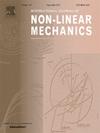Identification of nonlinear joints using amplitude-dependent modal parameters with high-accuracy reduction techniques
IF 2.8
3区 工程技术
Q2 MECHANICS
International Journal of Non-Linear Mechanics
Pub Date : 2025-05-09
DOI:10.1016/j.ijnonlinmec.2025.105155
引用次数: 0
Abstract
An efficient identification method using amplitude-dependent modal parameters is developed for systems with nonlinear joints. In this method, the nonlinear modal parameters of lightly damped systems are calculated by the extension of the periodic motion concept (EPMC). First, an exact reduction technique is applied to reduce computational effort due to the sparsity of the nonlinear force. Next, the frequency response function (FRF) matrix of the linear part is approximated using the incremental modal expansion, achieving high accuracy to speed up the solution process. An approach to identifying the parameters of the joint model is then introduced, which utilizes the EPMC and the reduction techniques. The objective function for minimization is calculated as a function of the errors between the calculated and measured nonlinear modal parameters, and the corresponding sensitivity matrix is derived. In this work, the modal motion amplitude of a certain reference degree of freedom (DOF) is used as a reference quantity to match the calculated and measured data in the identification process. The efficiency and convergence of the identification method are validated through both simulated and experimental case studies. Results indicate that the identification method can be successfully applied to practical assembly structures.
基于振幅相关模态参数的非线性关节识别与高精度降阶技术
针对具有非线性关节的系统,提出了一种基于幅值相关模态参数的有效辨识方法。该方法利用周期运动概念的推广,计算了轻阻尼系统的非线性模态参数。首先,由于非线性力的稀疏性,采用精确约简技术来减少计算量。其次,采用增量模态展开法对线性部分的频响函数矩阵进行近似,达到较高的精度,加快了求解过程。然后介绍了一种利用EPMC和约简技术识别关节模型参数的方法。将非线性模态参数计算值与实测值之间的误差作为最小化目标函数,并推导出相应的灵敏度矩阵。在识别过程中,以某参考自由度(DOF)的模态运动幅值作为参考量来匹配计算和测量数据。通过仿真和实验验证了该方法的有效性和收敛性。结果表明,该方法可以成功地应用于实际装配结构的识别。
本文章由计算机程序翻译,如有差异,请以英文原文为准。
求助全文
约1分钟内获得全文
求助全文
来源期刊
CiteScore
5.50
自引率
9.40%
发文量
192
审稿时长
67 days
期刊介绍:
The International Journal of Non-Linear Mechanics provides a specific medium for dissemination of high-quality research results in the various areas of theoretical, applied, and experimental mechanics of solids, fluids, structures, and systems where the phenomena are inherently non-linear.
The journal brings together original results in non-linear problems in elasticity, plasticity, dynamics, vibrations, wave-propagation, rheology, fluid-structure interaction systems, stability, biomechanics, micro- and nano-structures, materials, metamaterials, and in other diverse areas.
Papers may be analytical, computational or experimental in nature. Treatments of non-linear differential equations wherein solutions and properties of solutions are emphasized but physical aspects are not adequately relevant, will not be considered for possible publication. Both deterministic and stochastic approaches are fostered. Contributions pertaining to both established and emerging fields are encouraged.

 求助内容:
求助内容: 应助结果提醒方式:
应助结果提醒方式:


